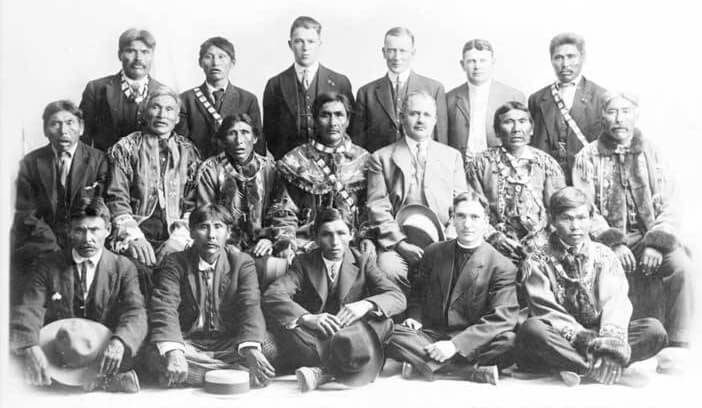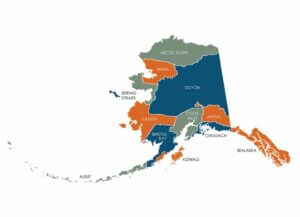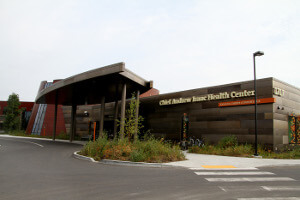While Tanana Chiefs Conference was not officially formed until 1962, the history of how our organization came to be can be dated back over one hundred years, when tribal Chiefs from throughout the region banded together to protect their native land rights, an issue that has continued after Alaska’s statehood in 1959 and is still relevant today.
Watch Our Centennial History Video
Our Story
In 1915, tribal Chiefs from throughout the region banded together to protect their native land rights. The Chiefs organized a meeting with the Government to protect a burial ground in Nenana from the Alaska Railroad. Present at that meeting were representatives from Tanana (or Ft. Gibbon), Crossjacket, Tolovana, Minto, Chena, and Salchaket, as well as Judge James Wickersham.

This meeting signified the beginning of a formal relationship with Athabascan Tribes and the United States Government. The Chiefs clearly expressed their priorities: to sustain the villages through employment, education, health care, lands protection, and specifically to protect access and management of tribal hunting and fishing resources. At the meeting, Julius Pilot of Nenana demanded the Chiefs receive notice of all federal actions which impact the tribes.
Becoming Tanana Chiefs Conference
Land conflicts became an increasing problem and statehood in 1959 only enhanced the threat to Native land interests. Although the Alaska Statehood Act recognized Native land rights, the State quickly put forward plans for projects that would have severely damaged Native land interests. In response, Al Ketzler, Sr. of Nenana helped organize a meeting of 32 villages at Tanana in June 1962. Tanana Chiefs Conference in its modern form was born out of this meeting, although it was not formally incorporated until 1971.
Acting as the conference’s first president, Ketzler organized a statewide coalition of Alaska Native leaders that resulted in Secretary of the Interior Stewart Udall freezing State land selections in 1966 until Native land claims were settled. After an historic struggle in which Ketzler and dozens of other Alaska Natives lived in Washington D.C. for weeks, Congress authorized a settlement of more than 44 million acres and nearly $1 billion to Alaska Natives through a corporate structure.
 ANCSA
ANCSA
The Alaska Native Claims Settlement Act (ANCSA) of December 1971 set up 13 regional for-profit corporations for Alaska Natives and nearly 200 village corporations. TCC incorporated Doyon, Limited as its regional for-profit corporation. ANCSA left a place for non-profit corporations to administer health and social service programs for the people, which TCC filled.
Early on, TCC developed a regional health authority to deliver Tribal health services. TCC acted quickly when the Indian Self Determination and Education Assistance Act of 1975 allowed it to become the regional provider for dozens of Bureau of Indian Affairs (BIA) programs. Also known as Public Law 93-638 or PL 638, this Act allowed Indian Tribes or Tribal consortiums to contract with the federal government to provide Indian program services directly to their own Tribal members.
Under PL 638, TCC contracted with the BIA to manage and deliver services such as housing, lands management, Tribal government assistance, education and employment, and natural resources management. TCC also contracted with the Alaska Area Native Health Service to provide services such as Community Health Aide, outreach, environmental health, mental health, and substance abuse counseling.
 Expansion of Services
Expansion of Services
By the late 1970’s, TCC had also successfully bid to deliver certain health care, social services, and public safety services to Interior residents, including rural non-Native residents, on behalf of the State of Alaska. In 1980, TCC decentralized its program operations away from Fairbanks by establishing subregional offices to serve the Upper Tanana, Yukon Flats, Yukon Tanana, Yukon Koyukuk, Lower Yukon, and Kuskokwim subregions. This structural shift provided more local employment, attention to subregional program priorities, and better client access to information and services.In the late 1980’s TCC assumed management of the Alaska Native Health Center in Fairbanks and renamed it the Chief Andrew Isaac Health- Center after the Traditional Athabascan Chief from Dot Lake. TCC also assumed the Contract Health Care program and developed innovative health facilities and services, including the Paul Williams House, the Dental and Eye Clinics, and several remote-site alcohol recovery camps.
TCC Today
In an effort to preserve traditional Athabascan culture and to utilize the knowledge of the region’s Elders, TCC established the office of the Traditional Chief within its corporate structure. The Traditional Chief, and the Second Traditional Chief in his absence, sits as an ex-officio (or non-voting) member of TCC’s Board. The Traditional Chief also serves as an ambassador of traditional knowledge and the Athabascan culture. TCC remains committed to the principles of leadership, advocacy, and Athabascan and Alaska Native culture that were initiated in their modern sense by the Tanana Chiefs generations.

 ANCSA
ANCSA Expansion of Services
Expansion of Services